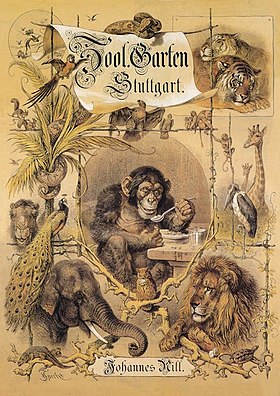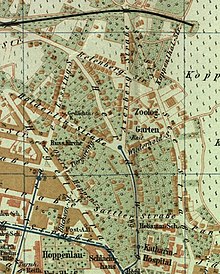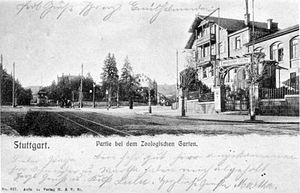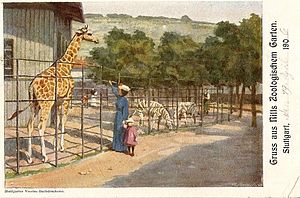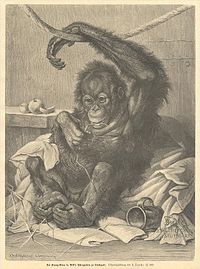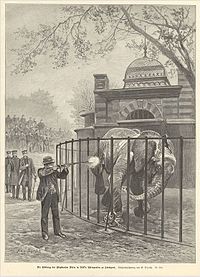Zoo Nill
Nills Tiergarten was a private zoo and between 1871 and 1906 one of the most popular excursion destinations in Stuttgart . It was located in what is now Azenbergstrasse.
location
Nill's zoo comprised what is now known as the Azenberg area, the area between Azenbergstrasse and Seestrasse or Relenbergstrasse and Wiederholdstrasse. At the corner of Wiederholdstrasse and Azenbergstrasse was Nill's “Restoration to the Hirschgarten”. In the immediate vicinity at the fork in the streets Hölderlinstraße, Herdweg and Azenbergstraße, the “Tiergartenlinie” of the electric tram stopped at the terminus “Hölderlinstraße / Herdweg” since 1901. The Tiergartenweg, a side street off Hölderlinstrasse, is still reminiscent of the former zoo today.
history
The master carpenter Johannes Nill (1825-1894) exhibited native animals in self-made cages on his premises on Herdweg from 1862 onwards. Due to its great success, he opened the Nill'schen Tiergarten on July 1, 1871. The zoologist Gustav Jäger was also involved. In the beginning, the zoo consisted of a bear pit, a monkey cage, a deer park and several ponds. The main attraction was a stuffed mammoth . In 1873, Nill took over many exotic animals from Affenwerner's bankruptcy estate . Then came elephants, zebras, lions, monkeys, snakes and jungle birds. A particular success was probably the world's first offspring of the great anteater . The site continued to expand until it reached 9,500 square feet in 1893.
In addition to the animal exhibition, there were also national shows and roller-skating races. In the 1890s the tamer Claire Heliot performed with her twelve lions, Käthe Paulus jumped off with the parachute. Up to 20,000 visitors were counted on Sundays. Richard Steiff designed his teddy bear based on the model of the brown bears in Nill's zoo.
Johannes Nill died in 1894 and his son, the veterinarian Adolf Nill (1861–1945), took over the management of the zoo. Adolf Nill achieved successes in breeding great apes, ostriches and anteaters. The animal population peaked at 500 animals, including a Sumatran rhinoceros in 1895 .
In the course of time, the city of Stuttgart grew closer and closer to the zoo, and the neighborhood increasingly complained about the odor and noise pollution. The Nill'sche Tiergarten was therefore closed on April 16, 1906, and the site was sold to the city of Stuttgart for one million marks . The animal population was partly sold to Theodor Widmann, who used it to build the zoo at the Doggenburg . Another part of the animal population and material was sold to the Tübingen zoo operator Eugen Mannheim, who used it to equip his private Tübingen zoo .
Views
Animal scenes
literature
General
- Uwe Albrecht: pleasure and teachings. The history of the bourgeois Stuttgart zoo in the 19th century.
- 1st part: G. Werner's "Zoological Garden" 1840–1874. In: The zoological garden , volume 70, 2000, pages 171–193, pdf .
- Part 2: Nills Zoo (1871–1906). In: The zoological garden , volume 71, 2001, pages 15–56.
- Carl Benjamin Klunzinger : History of the Stuttgart zoo. In: Annual Books of the Association for Patriotic Natural History , Volume 66, 1910, Pages 167–217, pdf . - With literature list.
- Jörg Kurz: Northern history (s). About the dwelling and life of the people in the north of Stuttgart. 2nd edition, Stuttgart 2005, pages 180-183.
- Jörg Kurz: From Affenwerner to Wilhelma - Stuttgart's legendary animal shows . Belser-Verlag , Stuttgart 2015, ISBN 978-3-7630-2701-9 , pages 24-57.
- Wolfgang Müller: Stuttgart in old views. Zaltbommel 1979, numbers 84, 85.
- Adolf Nill: Memorandum on the Stuttgart zoo question. Stuttgart 1931.
- Erik Raidt: Stuttgart Zoo History. The wonderful world of animals. In: Stuttgarter-Zeitung.de , September 16, 2012, [1] .
- Manfred Schmid: City history (s). A book accompanying the permanent exhibition of the Stuttgart City Archives. Stuttgart 1995, pages 67-68.
- Gustav Wais : Old Stuttgart's buildings in the picture: 640 pictures, including 2 colored ones, with explanations of city history, architectural history and art history. Stuttgart 1951, reprint Frankfurt am Main 1977, pages 602-605.
memories
- Julius Bazlen: At the Nill: Memories from the Tiergarten. Stuttgart 1925.
- Konrad Dreher : tear-off calendar of my life. Munich 1929, pages 89-91.
- Paul Eipper : Finally, the Herdweg joy and a Schiller song. In: A youth in Swabia: "the forged rose". Munich 1981, pages 358-378.
- Karl Gerok : The horror evening in the Thiergarten. Ballad. By a true story. In: Flowers and Stars: Poems. Stuttgart 1868, pages 471-476, pdf .
- Hedwig Lohß : Through the peep window: memories of the youth from old Stuttgart. Illustrated by Christine von Kalckreuth based on documents from the Stuttgart City Archives. Mühlacker 1972, pages 25-46.
- Hermann Missenharter: Dukes, citizens, kings: Stuttgart's history as it is not in a school book. Drawings by Heinrich Klumbies. Stuttgart 2005, pages 307-311.
- Richard Zanker: Beloved old Stuttgart: memories and encounters. Stuttgart 1965, pages 127-133.
Others
- Gottfried Bauer; Ulrich Theurer; Claude Jeanmaire: Stuttgart trams. A documentation about the tram lines from 1868–1975. Villigen (Switzerland) 1976.
- Gabriele Katz: Margarete Steiff: the biography. Karlsruhe 2015, pages 223–224.
Web links
Footnotes
- ^ History of the Chemical and Veterinary Investigation Office in Stuttgart, which built the buildings Azenbergstrasse 14 and 14a in 1908 on the site of the former Nill'schen Tiergarten.
- ↑ #Bauer 1976 , section Line 7, Line 4. - The Tiergarten line was called Line 7 from 1910.
- ↑ http://www.rhinoresourcecenter.com/pdf_files/120/1201183945.pdf
Coordinates: 48 ° 47 '10.3 " N , 9 ° 9' 56.8" E
